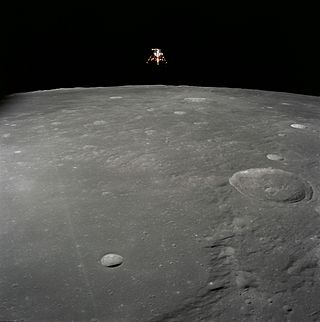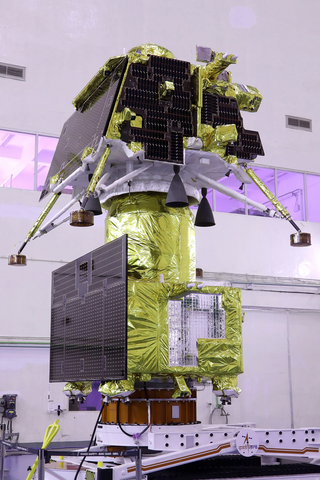
The Apollo Lunar Module, originally designated the Lunar Excursion Module (LEM), was the lunar lander spacecraft that was flown between lunar orbit and the Moon's surface during the United States' Apollo program. It was the first crewed spacecraft to operate exclusively in the airless vacuum of space, and remains the only crewed vehicle to land anywhere beyond Earth.

A Moon landing or lunar landing is the arrival of a spacecraft on the surface of the Moon. This includes both crewed and robotic missions. The first human-made object to touch the Moon was Luna 2, on 13 September 1959.

A lunar lander or Moon lander is a spacecraft designed to land on the surface of the Moon. As of 2023, the Apollo Lunar Module is the only lunar lander to have ever been used in human spaceflight, completing six lunar landings from 1969 to 1972 during the United States' Apollo Program. Several robotic landers have reached the surface, and some have returned samples to Earth.

The physical exploration of the Moon began when Luna 2, a space probe launched by the Soviet Union, made an impact on the surface of the Moon on September 14, 1959. Prior to that the only available means of exploration had been observation from Earth. The invention of the optical telescope brought about the first leap in the quality of lunar observations. Galileo Galilei is generally credited as the first person to use a telescope for astronomical purposes; having made his own telescope in 1609, the mountains and craters on the lunar surface were among his first observations using it.

The Google Lunar X Prize (GLXP) was a 2007–2018 inducement prize space competition organized by the X Prize Foundation, and sponsored by Google. The challenge called for privately funded teams to be the first to land a lunar rover on the Moon, travel 500 meters, and transmit back to Earth high-definition video and images.

Astrobotic Technology inc., commonly referred to as Astrobotic is an American private company that is developing space robotics technology for lunar and planetary missions. It was founded in 2007 by Carnegie Mellon professor Red Whittaker and his associates with the goal of winning the Google Lunar X Prize. The company is based in Pittsburgh, Pennsylvania. Their first launch occurred on January 8, 2024, as part of NASA's Commercial Lunar Payload Services (CLPS) program. The launch carried the company's Peregrine lunar lander on board the first flight of the Vulcan Centaur rocket from Florida's Space Force Station LC-41. The mission was unable to reach the Moon for a soft or hard landing. On June 11, 2020, Astrobotic received a second contract for the CLPS program. NASA will pay Astrobotic US$199.5 million to take the VIPER rover to the Moon, targeting a landing in November 2024.

Chandrayaan-2 is the second lunar exploration mission developed by the Indian Space Research Organisation (ISRO) after Chandrayaan-1. It consists of a lunar orbiter, the Vikram lunar lander, and the Pragyan rover, all of which were developed in India. The main scientific objective is to map and study the variations in lunar surface composition, as well as the location and abundance of lunar water.
Planetary Transportation Systems (PTS), formerly known as PTScientists and Part-Time Scientists, is a Berlin-based aerospace company. They developed the robotic lunar lander "ALINA" and seek to land on the Moon with it. They became the first German team to officially enter the Google Lunar X-Prize competition on June 24, 2009, but failed to reach the finals in 2017 for lack of a launch contract. During the summer of 2019, the company filed for bankruptcy, and the ALINA project was put on hold. In July 2021, PTS was selected with ArianeGroup to build ESA's ASTRIS kick-stage.
Moon Express is an American privately held company formed in 2010 by a group of Silicon Valley and space entrepreneurs. It had the goal of winning the $30 million Google Lunar X Prize, and of ultimately mining the Moon for natural resources of economic value. The company was not able to make a launch attempt to reach the Moon by March 31, 2018, the deadline for the prize.
TeamIndus is a private for-profit aerospace company headquartered in Bangalore, India. It consists of a team of professionals from various backgrounds in science, technology, finance, and media, that came together in 2010 with the aim of winning the Google Lunar X Prize competition announced in 2007. Although the competition ended in 2018 without a winner, TeamIndus is still working towards developing and launching their lunar rover mission sometime in 2020 after partnering with OrbitBeyond.

Luna 25 was a failed Russian lunar lander mission by Roscosmos in August 2023 that planned to land near the lunar south pole, in the vicinity of the crater Boguslawsky.
Arch Mission Foundation is a non-profit organization whose goal is to create multiple redundant repositories of human knowledge around the Solar System, including on Earth. The organization was founded by Nova Spivack and Nick Slavin in 2015 and incorporated in 2016.
ispace Inc. is a public Japanese company developing robotic spacecraft and other technology to compete for both transportation and exploration mission contracts from space agencies and other private industries. ispace's mission is to enable its clients to discover, map, and use natural lunar resources.

Beresheet was a demonstrator of a small robotic lunar lander and lunar probe operated by SpaceIL and Israel Aerospace Industries. Its aims included inspiring youth and promoting careers in science, technology, engineering, and mathematics (STEM), and landing its magnetometer, time capsule, and laser retroreflector on the Moon. The lander's gyroscopes failed on 11 April 2019 causing the main engine to shut off, which resulted in the lander crashing on the Moon. Its final resting position is 32.5956°N, 19.3496°E.
Beresheet 2 is a planned private space mission intended to land two spacecraft on the Moon in 2025. As the spacecraft reaches the Moon, it will split into three: the mothership (orbiter) and two landers that will be released for landing at different locations on the Moon. The orbiter will continue to orbit the Moon on a long-term multi-year mission. This will be the first-ever dual lander deployment mission, with the smallest landers to ever soft-land on the Moon. The Beresheet2 Orbiter will give many students worldwide the opportunity to learn the basics of space engineering and participate in deep-space science. Through its innovative design, Beresheet2 Orbiter will serve as the first-ever – worldwide interactive space education system. The project will include multiple educational activities for all ages and an outreach program that will connect and push these messages to the public in the partnering countries.

Chandrayaan-3 is the third mission in the Chandrayaan programme, a series of lunar-exploration missions developed by the Indian Space Research Organisation (ISRO). The mission consists of a Vikram lunar lander and a Pragyan lunar rover similar to those launched aboard Chandrayaan-2 in 2019, as well as a propulsion module that carried the spacecraft from Earth orbit to lunar orbit.












